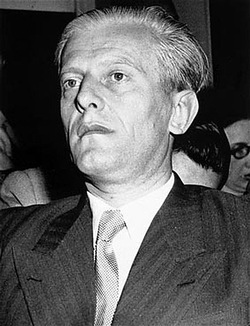
Otto Abetz He was captured by Allied authorities in the Schwarzwald in 1945. In
July 1949 a French court
sentenced Abetz to twenty years' imprisonment for
war crimes, particularly his role in arranging the
deportation of French
Jews to the death
camps. He was released on 17 April 1954 from Loos prison.
He died on 5 May 1958 in an auto
accident near Langenfeld
on the
Cologne-Ruhr autobahn.
July 1949 a French court
sentenced Abetz to twenty years' imprisonment for
war crimes, particularly his role in arranging the
deportation of French
Jews to the death
camps. He was released on 17 April 1954 from Loos prison.
He died on 5 May 1958 in an auto
accident near Langenfeld
on the
Cologne-Ruhr autobahn.
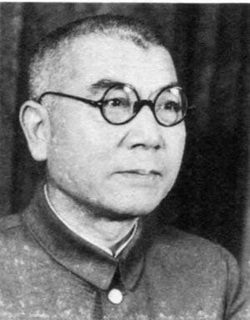
Akira Mutō 武藤 章
December 1892 – 23 December 1948 was a general in the Imperial Japanese Army during World War II After the surrender of Japan , Mutō was arrested by the American occupation authorities and charged with war crimes before the International Military Tribunal for the Far East. He
was convicted for atrocities against civilians and prisoners of war in both China and the Philippines,
and was executed by hanging on 23 December 1948.
December 1892 – 23 December 1948 was a general in the Imperial Japanese Army during World War II After the surrender of Japan , Mutō was arrested by the American occupation authorities and charged with war crimes before the International Military Tribunal for the Far East. He
was convicted for atrocities against civilians and prisoners of war in both China and the Philippines,
and was executed by hanging on 23 December 1948.

Zlatko Aleksovski was born on 8 January 1960 in Pakrac, Croatia Unlawful treatment of prisoners in Lašva Valley area in Bosnia and Herzegovina
Zlatko Aleksovski was arrested by Croatian
authorities on 8 June 1996 Sentenced to 7 years, granted early release
Zlatko Aleksovski was arrested by Croatian
authorities on 8 June 1996 Sentenced to 7 years, granted early release
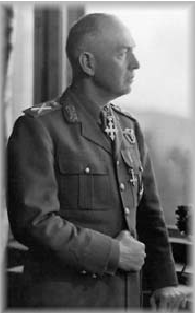
Ion Victor Antonescu (June 15, 1882 – June 1, 1946) was a Romanian soldier,
authoritarian politician and convicted war criminal.An atypical figure among
Holocaust perpetrators, Antonescu enforced policies independently responsible
for the deaths of as many as 400,000 people, most of them Bessarabian, Ukrainian
and Romanian Jews, as well as Romani Romanians. Ion Victor Antonescu was
executed by a military firing squad on June 1, 1946
authoritarian politician and convicted war criminal.An atypical figure among
Holocaust perpetrators, Antonescu enforced policies independently responsible
for the deaths of as many as 400,000 people, most of them Bessarabian, Ukrainian
and Romanian Jews, as well as Romani Romanians. Ion Victor Antonescu was
executed by a military firing squad on June 1, 1946
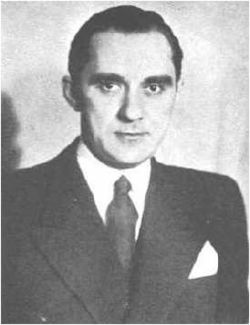
Mihai Antonescu (November 18, 1904 – June 1, 1946) was a Romanian politician who
served as Deputy Prime Minister and Foreign Minister during World War
II.Throughout 1941, Antonescu would approve the pogrom against the Jews of Iaşi,
stop the emigration of Jews from Romania, and remove the Romanian government’s
protection of Romanian Jews outside the country, thus leaving them in
German-occupied areas at the mercy of the Nazis. He also approved the slaughter
of Jews in Bessarabia and Bukovina, and the deportation of the survivors to
concentration camps in Transnistria.On August 23, 1944, as Soviet forces drew
closer and closer to Romania, King Michael dismissed the government of Ion
Antonescu, declared the nation’s surrender, and had Mihai Antonescu arrested. He
was subsequently handed over to the new authorities, tried by a Communist
Party-influenced Bucharest People's Tribunal, and found guilty of war crimes. He
was executed by a firing squad, together with Ion Antonescu, Constantin Vasiliu
and Gheorghe Alexianu, near the fort of Jilava.
served as Deputy Prime Minister and Foreign Minister during World War
II.Throughout 1941, Antonescu would approve the pogrom against the Jews of Iaşi,
stop the emigration of Jews from Romania, and remove the Romanian government’s
protection of Romanian Jews outside the country, thus leaving them in
German-occupied areas at the mercy of the Nazis. He also approved the slaughter
of Jews in Bessarabia and Bukovina, and the deportation of the survivors to
concentration camps in Transnistria.On August 23, 1944, as Soviet forces drew
closer and closer to Romania, King Michael dismissed the government of Ion
Antonescu, declared the nation’s surrender, and had Mihai Antonescu arrested. He
was subsequently handed over to the new authorities, tried by a Communist
Party-influenced Bucharest People's Tribunal, and found guilty of war crimes. He
was executed by a firing squad, together with Ion Antonescu, Constantin Vasiliu
and Gheorghe Alexianu, near the fort of Jilava.
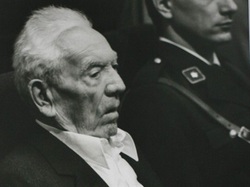
Andrija Artuković (29 November 1899 – 16 January 1988) was a Croatian politician
and a member of the Ustaše movement. Artuković was convicted of war crimes
committed against minorities in the Independent State of Croatia (NDH) during
World War II. His active participation in these crimes earned him the nickname
"the Himmler of the Balkans".During World War II, in 1941 Artuković became
Minister of the Interior in the newly-formed NDH. He was closely involved in the
mass murder of Serbs, Jews, Roma, and other minorities, and the opening of
concentration camps such as Jasenovac.The court in Zagreb issued a death
sentence on 14 May 1986, but a year later the authorities ruled that he was too
ill (with senile dementia) to be executed.
and a member of the Ustaše movement. Artuković was convicted of war crimes
committed against minorities in the Independent State of Croatia (NDH) during
World War II. His active participation in these crimes earned him the nickname
"the Himmler of the Balkans".During World War II, in 1941 Artuković became
Minister of the Interior in the newly-formed NDH. He was closely involved in the
mass murder of Serbs, Jews, Roma, and other minorities, and the opening of
concentration camps such as Jasenovac.The court in Zagreb issued a death
sentence on 14 May 1986, but a year later the authorities ruled that he was too
ill (with senile dementia) to be executed.
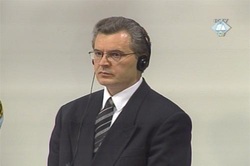
Milan Babić (Serbian Cyrillic: Милан Бабић; February 26, 1956 – March 5, 2006)
was from 1991 to 1995 the first President of the Republic of Serbian Krajina, a
Croatian region at the time of the war largely populated by a Serbs of Croatia
that wished to break away from Croatia.
He was indicted for war crimes by the International Criminal Tribunal for the Former Yugoslavia in 2004;
he was the first ever indictee to admit guilt and make a plea bargain with the
prosecution, after which he was sentenced to 13 years in prison. He was found
dead in his The Hague prison cell on March 6, 2006, having apparently committed
suicide.
was from 1991 to 1995 the first President of the Republic of Serbian Krajina, a
Croatian region at the time of the war largely populated by a Serbs of Croatia
that wished to break away from Croatia.
He was indicted for war crimes by the International Criminal Tribunal for the Former Yugoslavia in 2004;
he was the first ever indictee to admit guilt and make a plea bargain with the
prosecution, after which he was sentenced to 13 years in prison. He was found
dead in his The Hague prison cell on March 6, 2006, having apparently committed
suicide.
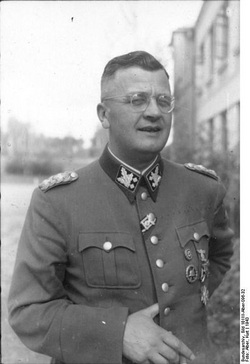
Erich Julius Eberhard von Zelewski or Erich von dem Bach-Zelewski (1 March
1899 - 8 March 1972), was a Nazi official and a member of the SS, in which he
reached the rank of SS-Obergruppenführer (General).
Units under his command killed approximately 200,000 civilians (more than
65,000 in mass executions) and an unknown number of POWs.
Von dem Bach-Zelewski went into hiding and tried to leave the country.
However, US military police arrested him on 1 August 1945. In exchange for his
testimony against his former superiors at the Nuremberg Trials, von dem
Bach-Zelewski never faced trial for any war crimes. Similarly, he never faced
extradition to Poland or to the USSR. He left prison in 1949.
In
1951, von dem Bach-Zalewski claimed that he had helped Hermann Göring commit
suicide in 1946. As evidence, he produced cyanide capsules to the authorities
with serial numbers not far removed from the one used by Göring. The authorities
never verified von dem Bach-Zalewski's claim, however, and did not charge him
with aiding Göring's death. Most modern day historians dismiss von dem
Bach-Zalewski's claim and agree that a U.S. Army contact within the Palace of
Justice's prison at Nuremberg most likely aided Göring in his
suicide.[2]
Also in 1951, von dem Bach-Zelewski was sentenced to 10
years in a labor camp for the murder of political opponents in the early 1930s;
however, he did not serve time until 1958, when he was convicted of killing
Anton von Hohberg und Buchwald, an SS officer, during the Night of the Long
Knives, and was sentenced to four and a half years imprisonment.[3] In 1961, he
was sentenced to an additional 10 years in home custody for the murder of 10
German Communists in the early 1930s. None of the sentences referred to his role
in Poland, in the East and his participation in the Holocaust, although he
openly admitted to having murdered Jews. He died in a Munich prison on 8 March
1972.
1899 - 8 March 1972), was a Nazi official and a member of the SS, in which he
reached the rank of SS-Obergruppenführer (General).
Units under his command killed approximately 200,000 civilians (more than
65,000 in mass executions) and an unknown number of POWs.
Von dem Bach-Zelewski went into hiding and tried to leave the country.
However, US military police arrested him on 1 August 1945. In exchange for his
testimony against his former superiors at the Nuremberg Trials, von dem
Bach-Zelewski never faced trial for any war crimes. Similarly, he never faced
extradition to Poland or to the USSR. He left prison in 1949.
In
1951, von dem Bach-Zalewski claimed that he had helped Hermann Göring commit
suicide in 1946. As evidence, he produced cyanide capsules to the authorities
with serial numbers not far removed from the one used by Göring. The authorities
never verified von dem Bach-Zalewski's claim, however, and did not charge him
with aiding Göring's death. Most modern day historians dismiss von dem
Bach-Zalewski's claim and agree that a U.S. Army contact within the Palace of
Justice's prison at Nuremberg most likely aided Göring in his
suicide.[2]
Also in 1951, von dem Bach-Zelewski was sentenced to 10
years in a labor camp for the murder of political opponents in the early 1930s;
however, he did not serve time until 1958, when he was convicted of killing
Anton von Hohberg und Buchwald, an SS officer, during the Night of the Long
Knives, and was sentenced to four and a half years imprisonment.[3] In 1961, he
was sentenced to an additional 10 years in home custody for the murder of 10
German Communists in the early 1930s. None of the sentences referred to his role
in Poland, in the East and his participation in the Holocaust, although he
openly admitted to having murdered Jews. He died in a Munich prison on 8 March
1972.
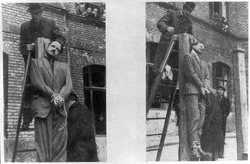
László Baky (September 13, 1898 in Budapest-March 29, 1946) was a leading
member of the Hungarian Nazi movement that flourished before and during World
War II.
Baky was removed from his positions during the summer of 1944 and was then
arrested after conspiring, unsuccessfully, to lead a coup against Miklós Horthy,
who also ordered Edmund Veesenmayer to stop the deportation of Jews. However
Baky would return to prominence that October after Szálasi and the Arrow Cross
were put in power by the Germans. Under the Arrow Cross he continued his labors
in deportation and mass murder. He fled the country in 1945 but was arrested in
Austria and returned to Budapest. In 1946 Baky, Endre and Jaross were all tried,
found guilty of crimes against the state, and executed.
member of the Hungarian Nazi movement that flourished before and during World
War II.
Baky was removed from his positions during the summer of 1944 and was then
arrested after conspiring, unsuccessfully, to lead a coup against Miklós Horthy,
who also ordered Edmund Veesenmayer to stop the deportation of Jews. However
Baky would return to prominence that October after Szálasi and the Arrow Cross
were put in power by the Germans. Under the Arrow Cross he continued his labors
in deportation and mass murder. He fled the country in 1945 but was arrested in
Austria and returned to Budapest. In 1946 Baky, Endre and Jaross were all tried,
found guilty of crimes against the state, and executed.
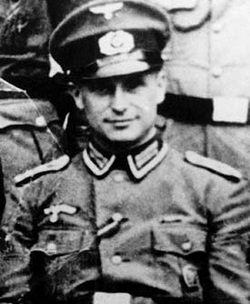
Nikolaus 'Klaus' Barbie (October 25, 1913 – September 25, 1991) was an
SS-Hauptsturmführer (rank approximately equivalent to army captain), Gestapo
member and war criminal. He was known as the Butcher of Lyon.
He first set up camp at Hôtel Terminus in Lyon. It was his time as head of
the Gestapo of Lyon that earned him the name Butcher of Lyon. Evidence suggests
that he personally tortured prisoners, men, women, and children alike, by
breaking extremities, sexual abuse using dogs, and electroshocks among other
methods.
On July 4, 1987, Barbie was sentenced to life imprisonment for crimes against
humanity, and died in jail in Lyon of leukemia four years later, at the age of
77.
SS-Hauptsturmführer (rank approximately equivalent to army captain), Gestapo
member and war criminal. He was known as the Butcher of Lyon.
He first set up camp at Hôtel Terminus in Lyon. It was his time as head of
the Gestapo of Lyon that earned him the name Butcher of Lyon. Evidence suggests
that he personally tortured prisoners, men, women, and children alike, by
breaking extremities, sexual abuse using dogs, and electroshocks among other
methods.
On July 4, 1987, Barbie was sentenced to life imprisonment for crimes against
humanity, and died in jail in Lyon of leukemia four years later, at the age of
77.
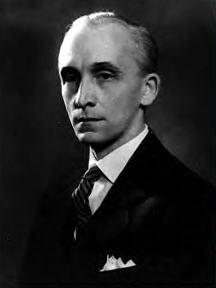
Dr. László Bárdossy de Bárdos (December 10, 1890 – January 10, 1946) was a
Hungarian diplomat and politician who served as Prime Minister of Hungary from
1941 to 1942.
On matters of domestic policy, Bárdossy proved to be an advocate of radical
right wing politics. An Anti-Communist, Bárdossy enacted the Third Jewish Law in
August 1941, which severely limited Jewish economic and employment opportunities
and prohibited Jews from marrying or having sexual intercourse with non-Jews.
Bárdossy also approved the policy of deporting non-Hungarians from the territory
seized from Yugoslavia, and authorized the slaughter of thousands of Jews in
Novi Sad. After Germany invaded the Soviet Union on June 22, 1941, Bárdossy was
restrained by Horthy from declaring war on the Soviet Union.
After resigning as prime minister, Bárdossy became chairman of the
Fascist United Christian National League in 1943. After the German occupation of
Hungary in 1944, Bárdossy and his followers collaborated with Prime Minister
Döme Sztójay and Ferenc Szálasi’s Arrow Cross Party. After World War II ended,
Bárdossy was arrested and tried by a People’s Court in November 1945. He was
found guilty of war crimes and collaboration with the Nazis, sentenced to death,
and executed by firing squad in Budapest in 1946.
Hungarian diplomat and politician who served as Prime Minister of Hungary from
1941 to 1942.
On matters of domestic policy, Bárdossy proved to be an advocate of radical
right wing politics. An Anti-Communist, Bárdossy enacted the Third Jewish Law in
August 1941, which severely limited Jewish economic and employment opportunities
and prohibited Jews from marrying or having sexual intercourse with non-Jews.
Bárdossy also approved the policy of deporting non-Hungarians from the territory
seized from Yugoslavia, and authorized the slaughter of thousands of Jews in
Novi Sad. After Germany invaded the Soviet Union on June 22, 1941, Bárdossy was
restrained by Horthy from declaring war on the Soviet Union.
After resigning as prime minister, Bárdossy became chairman of the
Fascist United Christian National League in 1943. After the German occupation of
Hungary in 1944, Bárdossy and his followers collaborated with Prime Minister
Döme Sztójay and Ferenc Szálasi’s Arrow Cross Party. After World War II ended,
Bárdossy was arrested and tried by a People’s Court in November 1945. He was
found guilty of war crimes and collaboration with the Nazis, sentenced to death,
and executed by firing squad in Budapest in 1946.
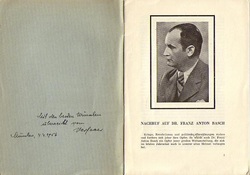
Dr. Franz Anton Basch (Hungarian: Basch Ferenc Antal) (July 13, 1901 – April 27,
1946) was a German Nazi politician, the chairman of Volksbund and the leader of
Germans in Hungary.
Franz was born in Zurich. He was a student of
Jakob Bleyer at the University of Budapest between 1920 and 1924. In 1925 he
became the secretary of the German Cultural Society of Hungary. He published
many works in this period.
From 1930, he began to express extreme
nationalist propaganda and became a follower of Nazism. In 1934 he resigned his
position because he affronted the Hungarian nation with his ideas. In 1938 he
founded his Nazi organization the People's Union Of Germans In Hungary (the
Volskbund) and became the chairman of it. In 1940 Hitler appointed him the
leader of Germans in Hungary (the Danube Swabians and the Transylvanian
Saxons).
In the end of the year 1944 he escaped to Germany, but was
delivered up to Hungary in 1945. He was marked as a war criminal and executed in
Budapest in 1946.
1946) was a German Nazi politician, the chairman of Volksbund and the leader of
Germans in Hungary.
Franz was born in Zurich. He was a student of
Jakob Bleyer at the University of Budapest between 1920 and 1924. In 1925 he
became the secretary of the German Cultural Society of Hungary. He published
many works in this period.
From 1930, he began to express extreme
nationalist propaganda and became a follower of Nazism. In 1934 he resigned his
position because he affronted the Hungarian nation with his ideas. In 1938 he
founded his Nazi organization the People's Union Of Germans In Hungary (the
Volskbund) and became the chairman of it. In 1940 Hitler appointed him the
leader of Germans in Hungary (the Danube Swabians and the Transylvanian
Saxons).
In the end of the year 1944 he escaped to Germany, but was
delivered up to Hungary in 1945. He was marked as a war criminal and executed in
Budapest in 1946.
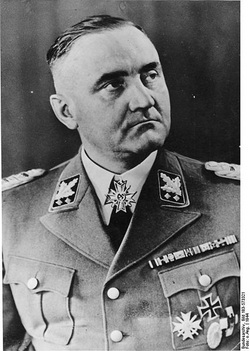
Gottlob Berger (16 July 1896 – 5 January 1975) was a German Nazi who held the
rank of Obergruppenführer during World War II and was later convicted of war
crimes.
He ran the main SS office in Berlin from 1940 and was involved in liaising
with the so called 'Eastern Territories'. In August 1944, he was sent to deal
with an uprising in Slovakia and immediately after this was put in control of
all prisoner of war camps.
After the war, he was arrested and put on trial in the Ministries Trial in
1947. In 1949, there was an attempt to assign blame for the POW death marches
against Berger and the indictment read:
that between September 1944 and May 1945, hundreds of thousands of American
and Allied prisoners of war were compelled to undertake forced marches in severe
weather without adequate rest, shelter, food, clothing and medical supplies; and
that such forced marches, conducted under the authority of the defendant Berger,
chief of Prisoner-of-War Affairs, resulted in great privation and deaths to many
thousands of prisoners.[2]
Berger claimed that it was in fact the
Germans' duty under the Geneva Convention to remove POWs from a potential combat
zone, as long as it did not put their lives in even greater danger. He also
claimed that the rapid advance of the Red Army had surprised the Germans, who
had planned to transport the POWs by train. He claimed that he had protested
about the decision, made by Hitler, according to him, but he was "without power
or authority to countermand or avoid the order". The case failed due to these
claims and the lack of eyewitness evidence—most ex-POWs were completely unaware
of the trial taking place.
He was however convicted in 1949 for
his role in the genocide of European Jews and sentenced to 25 years in prison.
The sentence was reduced to 10 years in 1951 because of his refusal to kill The
Prominente in Oflag IV-C at Colditz Castle, despite direct orders from Adolf
Hitler. He had helped these prisoners escape by moving them to Bavaria and then
onto Austria where he met up with them twice before they were returned to
American forces. He claimed that he had saved the Prominente as the head of the
Gestapo—Ernst Kaltenbrunner—had sent a group of extremists to try and kill
them.
After the war, he claimed that Hitler had wanted more
shootings of prisoners and more punishments, but that he had resisted this. In
1948, Berger gave details to an American judge in Nuremberg of Hitler's plans to
hold 35,000 Allied prisoners hostage in a "last redoubt" in the Bavarian
mountains. If a peace deal was not forthcoming, Hitler had ordered that the
hostages were to be executed. Berger claimed that on 22 April 1945, Hitler had
signed orders to this effect and these were passed to him by Eva Braun but he
decided to stall and not carry out the order.
After World War II,
Berger also claimed that there was a plan, proposed by the Luftwaffe and
approved by Hitler, to set up special POW camps for British and American airmen
in the center of large German cities to act as human shields against Allied
bombing raids. Berger realized that this would contravene the Geneva Convention
and argued that there was not enough barbed wire—as a result this plan was not
implemented.
After his release from prison in 1951, he worked on the staff of
the right-wing journal Nation Europa based in Coburg, and died on 5 January 1975
in his city of birth.
rank of Obergruppenführer during World War II and was later convicted of war
crimes.
He ran the main SS office in Berlin from 1940 and was involved in liaising
with the so called 'Eastern Territories'. In August 1944, he was sent to deal
with an uprising in Slovakia and immediately after this was put in control of
all prisoner of war camps.
After the war, he was arrested and put on trial in the Ministries Trial in
1947. In 1949, there was an attempt to assign blame for the POW death marches
against Berger and the indictment read:
that between September 1944 and May 1945, hundreds of thousands of American
and Allied prisoners of war were compelled to undertake forced marches in severe
weather without adequate rest, shelter, food, clothing and medical supplies; and
that such forced marches, conducted under the authority of the defendant Berger,
chief of Prisoner-of-War Affairs, resulted in great privation and deaths to many
thousands of prisoners.[2]
Berger claimed that it was in fact the
Germans' duty under the Geneva Convention to remove POWs from a potential combat
zone, as long as it did not put their lives in even greater danger. He also
claimed that the rapid advance of the Red Army had surprised the Germans, who
had planned to transport the POWs by train. He claimed that he had protested
about the decision, made by Hitler, according to him, but he was "without power
or authority to countermand or avoid the order". The case failed due to these
claims and the lack of eyewitness evidence—most ex-POWs were completely unaware
of the trial taking place.
He was however convicted in 1949 for
his role in the genocide of European Jews and sentenced to 25 years in prison.
The sentence was reduced to 10 years in 1951 because of his refusal to kill The
Prominente in Oflag IV-C at Colditz Castle, despite direct orders from Adolf
Hitler. He had helped these prisoners escape by moving them to Bavaria and then
onto Austria where he met up with them twice before they were returned to
American forces. He claimed that he had saved the Prominente as the head of the
Gestapo—Ernst Kaltenbrunner—had sent a group of extremists to try and kill
them.
After the war, he claimed that Hitler had wanted more
shootings of prisoners and more punishments, but that he had resisted this. In
1948, Berger gave details to an American judge in Nuremberg of Hitler's plans to
hold 35,000 Allied prisoners hostage in a "last redoubt" in the Bavarian
mountains. If a peace deal was not forthcoming, Hitler had ordered that the
hostages were to be executed. Berger claimed that on 22 April 1945, Hitler had
signed orders to this effect and these were passed to him by Eva Braun but he
decided to stall and not carry out the order.
After World War II,
Berger also claimed that there was a plan, proposed by the Luftwaffe and
approved by Hitler, to set up special POW camps for British and American airmen
in the center of large German cities to act as human shields against Allied
bombing raids. Berger realized that this would contravene the Geneva Convention
and argued that there was not enough barbed wire—as a result this plan was not
implemented.
After his release from prison in 1951, he worked on the staff of
the right-wing journal Nation Europa based in Coburg, and died on 5 January 1975
in his city of birth.
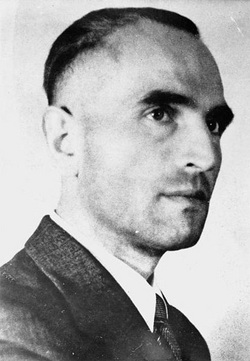
Dr. Werner Best (10 July 1903 – 23 June 1989) was a German Nazi, jurist,
police chief, SS-Obergruppenführer and Nazi Party leader from Darmstadt, Hesse.
He studied law and in 1927 obtained his doctorate degree at Heidelberg. Best
served as civilian administrator of France and Denmark while Nazi Germany
occupied those countries during World War II.
The director of the ministry of foreign affairs Nils Svenningsen in January
1944 suggested establishment of a Danish camp in order to avoid deportations to
Germany.[6] Best accepted this suggestion, but on condition that this camp was
built close to the German border. Frøslev Prison Camp was set up in August
1944.
Due to the Danish cabinet's decision on 9 April 1940 to
accept cooperation with German authorities, the Danish police consequently
cooperated with the German occupation forces. This arrangement remained in
effect even after the resignation of the Danish government on 29 September 1943.
On 12 May 1944, Best demanded that the Danish police should take over the task
of protecting 57 specific enterprises sabotaged by the Danish resistance
movement, which was growing in strength. Should the Danish civil service not
accept this, the Danish police force would be reduced to 3,000 men. The head of
the Danish administration, Nils Svenningsen, was inclined to accept this demand,
but the organizations of the Danish police were opposed to the idea. The German
request was ultimately turned down, and this was reported to Best on 6 June
1944. This reduced the Gestapo's already limited trust in the Danish police even
further, and on 19 September 1944, the German army began arresting members of
the Danish police forces. 1,960 policemen were arrested and deported to German
KZ and prisoner of war camps.
In 1948, Best was sentenced to death by a Danish court, but his sentence was
reduced to 12 years in prison, and he was released in 1951. Best was fined by a
Berlin de-Nazification court in 1958 for his actions during the war and was
later charged in 1972 when further war crimes allegations arose. He was found
medically unfit to stand trial and was released.
After that, Best was part of a network that helped old SS comrades. He died in Mülheim, North
Rhine-Westphalia, in 1989.
police chief, SS-Obergruppenführer and Nazi Party leader from Darmstadt, Hesse.
He studied law and in 1927 obtained his doctorate degree at Heidelberg. Best
served as civilian administrator of France and Denmark while Nazi Germany
occupied those countries during World War II.
The director of the ministry of foreign affairs Nils Svenningsen in January
1944 suggested establishment of a Danish camp in order to avoid deportations to
Germany.[6] Best accepted this suggestion, but on condition that this camp was
built close to the German border. Frøslev Prison Camp was set up in August
1944.
Due to the Danish cabinet's decision on 9 April 1940 to
accept cooperation with German authorities, the Danish police consequently
cooperated with the German occupation forces. This arrangement remained in
effect even after the resignation of the Danish government on 29 September 1943.
On 12 May 1944, Best demanded that the Danish police should take over the task
of protecting 57 specific enterprises sabotaged by the Danish resistance
movement, which was growing in strength. Should the Danish civil service not
accept this, the Danish police force would be reduced to 3,000 men. The head of
the Danish administration, Nils Svenningsen, was inclined to accept this demand,
but the organizations of the Danish police were opposed to the idea. The German
request was ultimately turned down, and this was reported to Best on 6 June
1944. This reduced the Gestapo's already limited trust in the Danish police even
further, and on 19 September 1944, the German army began arresting members of
the Danish police forces. 1,960 policemen were arrested and deported to German
KZ and prisoner of war camps.
In 1948, Best was sentenced to death by a Danish court, but his sentence was
reduced to 12 years in prison, and he was released in 1951. Best was fined by a
Berlin de-Nazification court in 1958 for his actions during the war and was
later charged in 1972 when further war crimes allegations arose. He was found
medically unfit to stand trial and was released.
After that, Best was part of a network that helped old SS comrades. He died in Mülheim, North
Rhine-Westphalia, in 1989.
